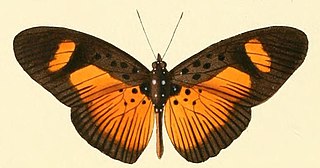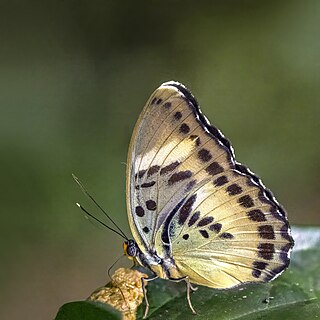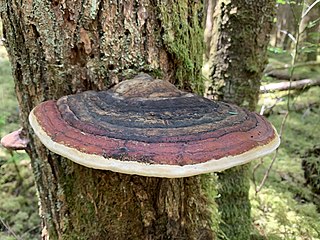
The Adonis blue is a butterfly in the family Lycaenidae. It inhabits the Palearctic realm.

Fomitopsis pinicola, is a stem decay fungus common on softwood and hardwood trees. Its conk is known as the red-belted conk. The species is common throughout temperate Europe and Asia. It is a decay fungus that serves as a small-scale disturbance agent in coastal rainforest ecosystems. It influences stand structure and succession in temperate rainforests. It performs essential nutrient cycling functions in forests. As well as a key producer of brown rot residues that are stable soil components in coniferous forest ecosystems. It has been reported that mushrooms have significant antioxidant activity.

Apatura ilia, the lesser purple emperor, is a species of butterfly native to most of Europe and east across the Palearctic. It is named for its similarity to the purple emperor butterfly.

Laricifomes officinalis, also known as agarikon, eburiko, or the quinine conk, is a wood-decay fungus that causes brown heart rot on conifers native to Europe, Asia, and North America, as well as Morocco. This fungus is the only member of the genus Laricifomes, in the order Polyporales. The fruiting bodies grow in large conks on the trunks of trees.

Scotopteryx chenopodiata, the shaded broad-bar, is a moth of the family Geometridae. It was first described by Carl Linnaeus in his 1758 10th edition of Systema Naturae.

Fomitopsis is a genus of more than 40 species of bracket fungi in the family Fomitopsidaceae.

Acraea natalica, the Natal acraea, is a butterfly of the family Nymphalidae, which is native to East and southern Africa.

Acraea caldarena, the black tip acraea or black-tipped acraea, is a butterfly of the family Nymphalidae. It is found in southern and southeastern Africa.

Acraea anemosa, the broad-bordered acraea, is a butterfly of the family Nymphalidae which is native to southern Africa and coastal East Africa.

Acraea encedon, the common acraea, white-barred acraea or encedon acraea, is a butterfly of the family Nymphalidae. It is found in sub-Saharan Africa and south-western Arabia. It is one of the species of Acraea sometimes separated in Telchinia.

Pseudacraea eurytus, the false wanderer, is a butterfly of the family Nymphalidae. It is found in Africa.

Pseudacraea lucretia, the false diadem or false chief, is a butterfly of the family Nymphalidae. It is found in Africa.

Fomes fomentarius is a species of fungal plant pathogen found in Europe, Asia, Africa and North America. The species produces very large polypore fruit bodies which are shaped like a horse's hoof and vary in colour from a silvery grey to almost black, though they are normally brown. It grows on the side of various species of tree, which it infects through broken bark, causing rot. The species typically continues to live on trees long after they have died, changing from a parasite to a decomposer.

Charaxes etheocles, the demon charaxes, is a butterfly in the family Nymphalidae. It is found in Senegal, Guinea, Sierra Leone, Liberia, Ivory Coast, Ghana, Togo, Nigeria, Cameroon, Gabon, the Central African Republic, the Republic of the Congo, Angola, the Democratic Republic of the Congo, Sudan, Ethiopia, Uganda, Kenya, Tanzania and Zambia.

Acraea jodutta, the jodutta acraea, is a butterfly in the family Nymphalidae. It is found in Guinea, Sierra Leone, Liberia, Ivory Coast, Ghana, Togo, Nigeria, Cameroon, Equatorial Guinea, São Tomé and Príncipe, Gabon, the Republic of the Congo, the Central African Republic, Angola, the Democratic Republic of the Congo, Sudan, Uganda, Kenya and Ethiopia.

Acraea parrhasia, the yellow-veined acraea, is a butterfly in the family Nymphalidae which is native to sub-Saharan Africa.

Acraea penelope, the Penelope acraea or Penelope's acraea, is a butterfly in the family Nymphalidae. It is found in Nigeria, Cameroon, the Republic of the Congo, the Democratic Republic of the Congo, Uganda, Kenya and Tanzania. The habitat consists of sub-montane forests.

Euphaedra ceres, the Ceres forester, is a butterfly in the family Nymphalidae. It is found in Gambia, Guinea, Sierra Leone, Liberia, Ivory Coast, Ghana, Togo, Benin, Nigeria, Cameroon, Gabon and the Republic of the Congo.

Fomitopsis ochracea is a polypore fungus found in North America. It was isolated from Albertan forests, and can be found in British Columbia. It has been isolated as far East as Newfoundland, but prefers Northern climates. It can be isolated throughout the Appalachian range, as far down as Georgia. It is a detritivore on both hardwood trees and conifers, causing a brown cubical rot. It is a member of the genus Fomitopsis, a common group of perennial fungi.

Fomitopsis mounceae is a species of shelf fungus. Originally thought to be identical to the red-belted conk, studies show that it is in fact a discrete species. The original specimen was isolated from Edson, Alberta on a poplar tree. This species was named after Irene Mounce, a Canadian mycologist.




















